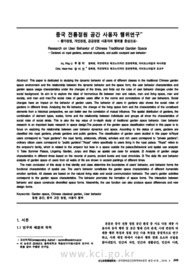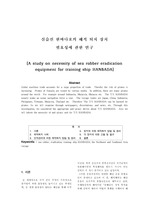

-
미리보기
서지정보
· 발행기관 : 한국문화공간건축학회
· 수록지 정보 : 한국문화공간건축학회논문집 / 67호 / 257 ~ 268페이지
· 저자명 : 후핑리, 정미선
초록
This paper is dedicated to studying the dynamic behavior of users of different classes in the traditional Chinese garden space environment and the relationship between the dynamic behavior and the space form, the user behavior characteristics and garden space usage characteristics under the changes of the times, and finds out the rules of user behavior changes under the social background. Its aim is to explore the ideal of harmonious life between man and nature, man and living space, man and society, and man and man.The social roles of garden users differ in the norms and connotations of their use behaviors. Social changes have an impact on the behavior of garden users. The behavior of users in gardens also shows the social roles of gardens in different times. Analyzing the life behavior, the change of the living space form and the characteristics of the constituent elements from a historical perspective, we can better see the correlation of mutual influence. The spatial distribution of gardens, the combination of element types, scales, forms and the relationship between individuals and groups all show the characteristics of social roles of social strata. This is also the key value of in-depth study of traditional garden space behavior. User behavior research is an important basic research in space design.The purpose of the garden space classification method in this paper is to focus on exploring the relationship between user behavior dynamics and space. According to the status of users, gardens are classified into royal gardens, private gardens and public gardens. The classification of garden users studied in this paper is:Royal users correspond to "royal gardens"; the royal family, aristocrats, officials, scholars and rich users correspond to "private gardens"; ordinary citizen users correspond to "public gardens"."Royal" refers specifically to users living in the royal palace. "Royal" refers to the emperor's family, which is related to the emperor but lives in a space outside the palace.Behavioral and spatial use analysis: 1) Take Summer Palace, Lingering Garden, Junpu and Biepu as spatial use case for analysis. 2) Analysis of garden usage characteristics in different times based on the records of poems, ancient books and local chronicles. 3) The daily life and behavior analysis of garden space of users from all walks of life are shown in ancient paintings of different times.
The main conclusion of this study is that identity and class determine the boundaries of users' behavior, and behavior forms the functional characteristics of spatial use. The user's behavior constitutes the garden space characteristics of different humanistic emotion symbols. All classes are based on the natural living state and social communication behavior. The user's garden activities correspond to the garden space characteristics. The behavior promotes the formation of space forms. The interaction between behavior and space constructs diversified space forms. Meanwhile, the use function can also produce space differences and new design forms.영어초록
This paper is dedicated to studying the dynamic behavior of users of different classes in the traditional Chinese garden space environment and the relationship between the dynamic behavior and the space form, the user behavior characteristics and garden space usage characteristics under the changes of the times, and finds out the rules of user behavior changes under the social background. Its aim is to explore the ideal of harmonious life between man and nature, man and living space, man and society, and man and man.The social roles of garden users differ in the norms and connotations of their use behaviors. Social changes have an impact on the behavior of garden users. The behavior of users in gardens also shows the social roles of gardens in different times. Analyzing the life behavior, the change of the living space form and the characteristics of the constituent elements from a historical perspective, we can better see the correlation of mutual influence. The spatial distribution of gardens, the combination of element types, scales, forms and the relationship between individuals and groups all show the characteristics of social roles of social strata. This is also the key value of in-depth study of traditional garden space behavior. User behavior research is an important basic research in space design.The purpose of the garden space classification method in this paper is to focus on exploring the relationship between user behavior dynamics and space. According to the status of users, gardens are classified into royal gardens, private gardens and public gardens. The classification of garden users studied in this paper is:Royal users correspond to "royal gardens"; the royal family, aristocrats, officials, scholars and rich users correspond to "private gardens"; ordinary citizen users correspond to "public gardens"."Royal" refers specifically to users living in the royal palace. "Royal" refers to the emperor's family, which is related to the emperor but lives in a space outside the palace.Behavioral and spatial use analysis: 1) Take Summer Palace, Lingering Garden, Junpu and Biepu as spatial use case for analysis. 2) Analysis of garden usage characteristics in different times based on the records of poems, ancient books and local chronicles. 3) The daily life and behavior analysis of garden space of users from all walks of life are shown in ancient paintings of different times.
The main conclusion of this study is that identity and class determine the boundaries of users' behavior, and behavior forms the functional characteristics of spatial use. The user's behavior constitutes the garden space characteristics of different humanistic emotion symbols. All classes are based on the natural living state and social communication behavior. The user's garden activities correspond to the garden space characteristics. The behavior promotes the formation of space forms. The interaction between behavior and space constructs diversified space forms. Meanwhile, the use function can also produce space differences and new design forms.참고자료
· 없음태그
-
자주묻는질문의 답변을 확인해 주세요

꼭 알아주세요
-
자료의 정보 및 내용의 진실성에 대하여 해피캠퍼스는 보증하지 않으며, 해당 정보 및 게시물 저작권과 기타 법적 책임은 자료 등록자에게 있습니다.
자료 및 게시물 내용의 불법적 이용, 무단 전재∙배포는 금지되어 있습니다.
저작권침해, 명예훼손 등 분쟁 요소 발견 시 고객센터의 저작권침해 신고센터를 이용해 주시기 바랍니다. -
해피캠퍼스는 구매자와 판매자 모두가 만족하는 서비스가 되도록 노력하고 있으며, 아래의 4가지 자료환불 조건을 꼭 확인해주시기 바랍니다.
파일오류 중복자료 저작권 없음 설명과 실제 내용 불일치 파일의 다운로드가 제대로 되지 않거나 파일형식에 맞는 프로그램으로 정상 작동하지 않는 경우 다른 자료와 70% 이상 내용이 일치하는 경우 (중복임을 확인할 수 있는 근거 필요함) 인터넷의 다른 사이트, 연구기관, 학교, 서적 등의 자료를 도용한 경우 자료의 설명과 실제 자료의 내용이 일치하지 않는 경우
“한국문화공간건축학회논문집”의 다른 논문도 확인해 보세요!
-
서점의 지역문화 플랫폼(Platform)으로서 활용 모색에 관한 연구 10 페이지
With the change of consumer's lifestyles and the emergence of online bookstores, bookstores can no longer stay as book-selling space, and the number of bookstores is gradually decreasing with consumpt.. -
뮤지엄 공간큐레이팅에서의 전통성 표현 연구 8 페이지
The purpose of this study is to examine the effect of modernization on the exhibition and communication of contents by examining the expression of traditionalism in the museum exhibition space and ult.. -
모듈러 시스템을 적용한 일본 현대 건축가의 파빌리온 연구 8 페이지
Pavilion architecture is the object of social communication in the boundaries of architecture and art. Also, the current Pavilion, which is making various attempts to solve many problems in society ac.. -
개인 사무실의 조명기기 배치조건에 대한 사용자 만족도 예측 8 페이지
This study examines the effects of layouts of lighting fixtures to users’ satisfaction in a private office space. Four lighting designs alternatives were applied to an office space to provide a requir.. -
천공 모델링조건 변화에 대한 소규모 사무실의 주광조도 예측 10 페이지
This study investigates the accuracy of simulation methods for the predictions of daylight illuminance in a small office space. Theoretical computation algorithms for the prediction were developed and..
찾으시던 자료가 아닌가요?
지금 보는 자료와 연관되어 있어요!
문서 초안을 생성해주는 EasyAI



